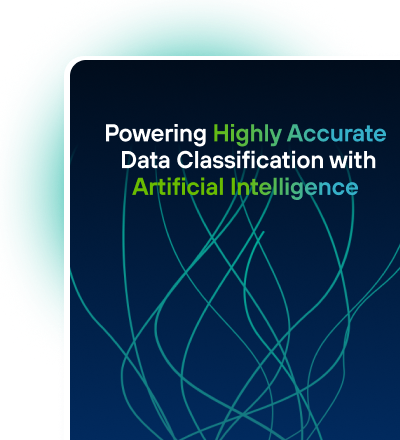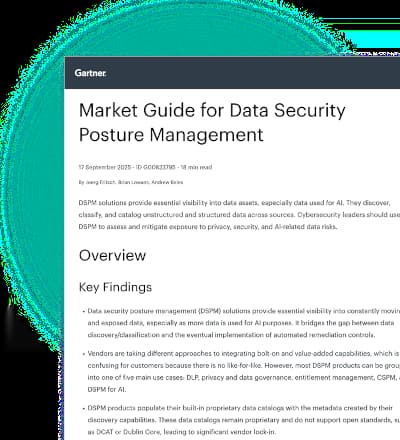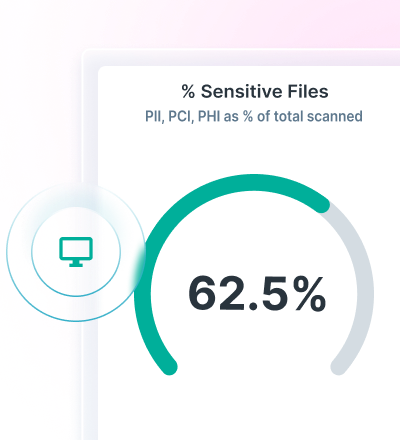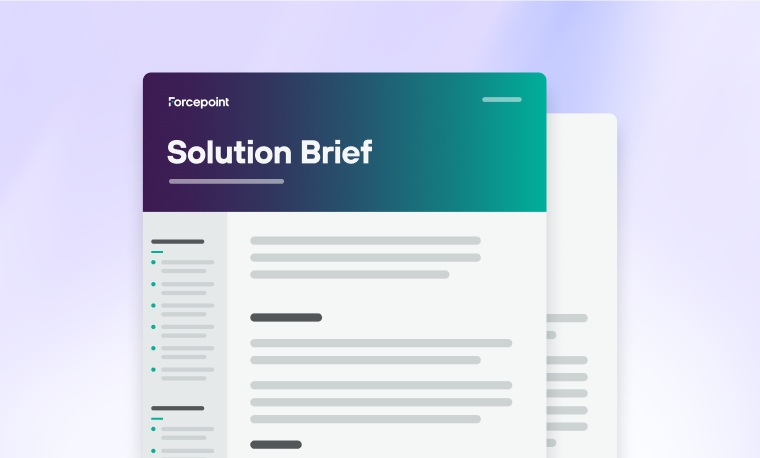
12,000명 이상의 고객이 잘못할 수 없습니다










































클라우드에서 데이터를 확인하기 위해 고심하고 계신가요?
혼자가 아닙니다. 시장에 80만 개 이상의 클라우드 애플리케이션이 나와 있기 때문에 기존 데이터 보안 도구는 SaaS 정책 관리의 복잡성과 AI 주도적 데이터 증가로 인해 압도될 수 있습니다.
심각한 클라우드 보안 인시던트를 경험한 조직의 비율*
클라우드에 저장된 기업 데이터의
비율*
AI 에이전트가 액세스할 수 있는
데이터에 대한 가시성이 부족한 기업의 비율***
CASB를 사용하여 SaaS 및 GenAI 앱에서 데이터를 보고 보호하세요.
Forcepoint CASB는 Microsoft 365, Google Workspace, Salesforce와 같은 전 세계에서 가장 인기 있는 SaaS 애플리케이션에 대한 액세스를 보호합니다. 이 솔루션은 기업이 승인한 어플리케이션 내에서 미사용 중인 데이터를 스캔하여 Forcepoint Data Loss Prevention(DLP) 소프트웨어와의 통합을 통해 데이터에 대한 진정한 가시성과 제어권을 제공합니다.
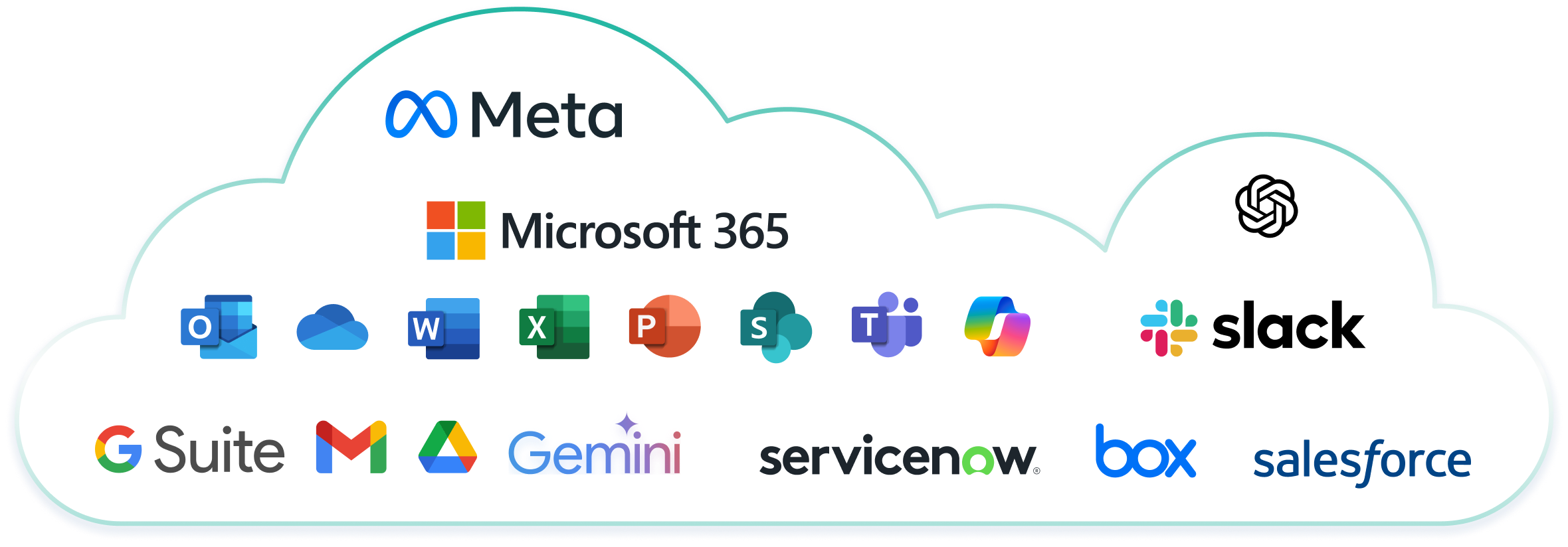
Forcepoint CASB 솔루션 vs. 경쟁 제품
Forcepoint | 레거시 보안 공급업체 | 레거시 네트워킹 공급업체 | |
Cloud Access Security Broker(CASB) 기능
| |||
데이터 보안 기능
|
면책 조항: 제품 비교는 2023년 3월 1일을 기준으로 동일한 공급업체에서 제공하는 제품 내 기능 및 포트폴리오 간 통합을 기반으로 합니다. 타사 공급업체와의 통합은 비교 대상에서 제외됩니다. 기능 비교는 2023년 3월 1일 현재 기준으로 사용 가능한 각 공급업체의 최신 버전을 기반으로 합니다. 정보는 2023년 3월 1일 현재 기준으로 공용 웹사이트 및 포럼, 분석 보고서, 제품 데이터시트에서 수집한 데이터를 기반으로 산정한 것입니다.
SaaS 보안을 유지하기 위한 중요한 CASB 기능
SaaS 데이터에 대한 심층적인 가시성
SaaS 앱 전반에서 데이터에 대한 완전한 가시성을 확보하세요. 사전 구축된 사용자 지정 가능한 대시보드를 통해 보안, 컴플라이언스, 감사 팀은 직관적인 인사이트로 신속하게 행동할 수 있습니다.
데이터 보호 및 컴플라이언스 간소화
클라우드에서 데이터 손실을 방지하기 위해 동급 최고의 DLP를 CASB로 확장해 보세요. 1,700개 이상의 분류기와 정책 템플릿으로 정책 구성 및 컴플라이언스 관리를 간소화합니다.
모든 장치에서 보안 액세스
하이브리드 작업자가 모든 장치와 위치에서 SaaS 애플리케이션에 대한 안전한 Zero Trust 액세스로 권한을 부여해 보세요. 에이전트리스 배포 모드는 사용자 생산성을 유지하고 데이터를 보호합니다.

위협 수정 자동화
SaaS 앱의 맬웨어, 데이터 과도한 노출, 정책 위반과 같은 SaaS 위협을 자동으로 탐지하고 대응하여 침해 영향을 최소화합니다.
Secure Microsoft Copilot
with Forcepoint CASB
Prevent unintended data exposure and ensure safe AI adoption across Microsoft 365.
- Gain visibility and control over Copilot prompts, responses, and file attachments.
- Detect and classify sensitive data in AI interactions.
- Enable audit and remediation workflows for compliance and responsible AI use.
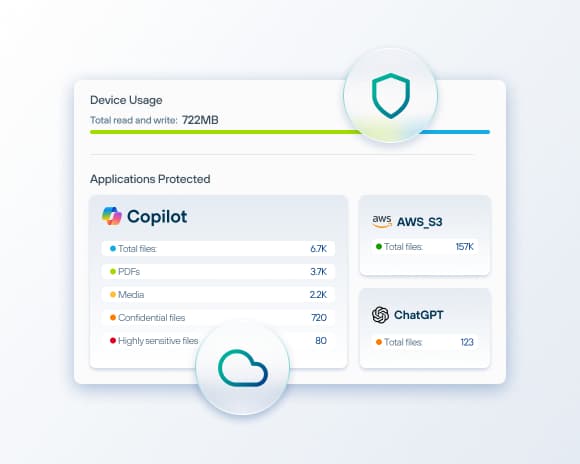


Microsoft 365 데이터 보안 플레이북
Microsoft 365는 세계에서 가장 인기 있는 클라우드 응용 프로그램 중 하나입니다. Forcepoint CASB는 M365 애플리케이션 내의 데이터 보안을 강화하여 사용자 생산성을 향상시키고 조직에 민감한 데이터가 안전하다는 확신을 제공합니다.
Why Customers Choose Forcepoint CASB Solution
Why Customers Choose Forcepoint CASB Solution
"Very good experience in getting visibility into and protection of cloud application, policy enforcement and user behavior."
Read the Review자주 묻는 질문
Forcepoint CASB는 많은 클라우드 애플리케이션과 어떻게 통합되나요?
Forcepoint CASB(클라우드 접근 보안 브로커)는 API 기반, 리버스 프록시, 포워드 프록시 방법 조합을 사용하여 80만 개 이상의 클라우드 애플리케이션과 통합됩니다. 이 하이브리드 접근 방식을 통해 사용자가 해당 앱에 액세스하는 방식에 관계없이 거의 모든 SaaS, IaaS 또는 사설 클라우드 환경에서 데이터를 모니터링하고 보호할 수 있습니다.
- API 기반: Microsoft 365, Salesforce, Google Workspace와 같은 허가된 앱에 대한 심층적인 가시성에 가장 적합합니다. 이 기능을 통해 사용자 활동을 감사하고 위협을 탐지하며 소급으로도 DLP 정책을 적용할 수 있습니다.
- 리버스 프록시: 관리형 장치에서 클라우드 트래픽을 인라인 보호하는 데 적합합니다. 다운로드 차단 또는 단계별 인증 적용과 같은 실시간 세션 제어를 가능하게 합니다.
- 포워드 프록시: 관리되지 않는 장치나 BYOD 시나리오를 보호할 때 유용합니다. Forcepoint의 프록시를 통해 아웃바운드 트래픽을 클라우드 서비스로 라우팅하기 때문에 데이터가 앱에 도달하기 전에 정책을 적용할 수 있습니다.
Cloud Access Security Broker(CASB) 솔루션이란 무엇인가요?
Cloud Access Security Broker(CASB)는 클라우드 사용자와 클라우드 공급자 사이에서 중개자 역할을 하는 보안 솔루션입니다. 멀웨어를 방지하고 암호화를 통해 데이터를 보호하여 데이터 스트림을 무단 당사자가 읽을 수 없도록 만들어 사이버 공격으로부터 조직을 보호합니다. CASB는 SaaS 애플리케이션에 대한 데이터 보안 및 액세스 관리를 제공하여 안전하고 규정이 준수되는 클라우드 사용을 보장합니다.
CASB는 어떤 방식으로 작동하고 기능합니까?
CASB 소프트웨어는 조직의 보안 정책을 적용하여 사내 IT 아키텍처와 클라우드 벤더 환경 사이의 데이터 흐름을 보호합니다. 클라우드 애플리케이션과 해당 애플리케이션에 포함된 데이터와의 사용자 상호 작용을 제어하여 클라우드 리소스에 대한 안전하고 규정이 준수되는 액세스를 보장합니다.
CASB의 목적은 무엇인가요?
CASB의 주 목적은 관리형 및 비관리형 클라우드 애플리케이션 모두에서 데이터를 보호하는 것입니다. 이를 통해 조직은 데이터 사용을 관리하는 정책을 생성하여 데이터 탈취 및 유출과 같은 위험을 완화할 수 있습니다. 또한 CASB는 승인되지 않은 SaaS 애플리케이션을 식별하고 관리하여 섀도우 IT 문제를 해결합니다.
CASB는 클라우드 보안을 어떻게 향상시켜 주나요?
CASB는 클라우드 애플리케이션 사용에 대한 가시성을 제공하고, 데이터 보안 정책을 적용하고, 위협으로부터 보호함으로써 클라우드 보안을 강화합니다. 사용자 활동을 모니터링하고 이상 징후를 탐지하며 컴플라이언스를 준수하는지 확인합니다. 사용자와 클라우드 서비스 사이의 보안 체크포인트 역할을 통해 CASB는 데이터 침해와 무단 액세스를 방지하는 데 도움이 됩니다.
CASB는 컴플라이언스에 어떤 도움을 주나요?
CASB는 클라우드 사용을 모니터링하고 GDPR, HIPAA, SOX, PCI DSS 등과 같은 업계 규정에 부합하는 정책을 적용하여 컴플라이언스를 지원합니다. 컴플라이언스를 입증하기 위해 상세한 보고서와 감사를 제공하여 조직이 벌금과 법적 문제를 피할 수 있도록 도와줍니다. 또한 CASB는 지역별 데이터 보호법에 따라 데이터가 저장되고 처리되도록 합니다.
CASB는 섀도우 IT의 문제를 어떻게 해결하나요?
CASB는 조직 내에서 사용되는 무단 클라우드 애플리케이션을 발견하고 모니터링하여 섀도우 IT 문제를 해결합니다. 모든 클라우드 서비스에 대한 가시성을 제공하고, 위험 수준을 평가하고, 사용을 관리하고 통제하기 위해 보안 정책을 적용합니다. 이를 통해 조직은 승인되지 않은 클라우드 애플리케이션과 관련된 위험을 완화할 수 있습니다.
SaaS 애플리케이션을 사용하는 조직에 CASB가 중요한 이유는 무엇입니까?
CASB는 SaaS 애플리케이션을 사용하는 조직에서 포괄적인 보안 및 컴플라이언스 관리를 제공하기 때문에 매우 중요합니다. 조직이 클라우드에서 데이터를 제어하고, 사이버 위협으로부터 보호하며, 클라우드 사용이 규정 요구 사항을 준수하도록 보장할 수 있습니다. 또한 CASB는 무단 클라우드 애플리케이션을 식별하고 관리하여 섀도우 IT의 문제도 해결합니다.
효과적인 CASB의 기둥은 무엇인가?
가시성: 기업은 정보 자산이 관리되고 거버넌스 프로세스를 준수하기 위해 사용자 계정, 부서, 위치, 장치 등을 포함하여 클라우드 앱 사용에 대한 가시성이 필요합니다.
데이터 보안: CASB는 클라우드 파일 스토리지를 모니터링하고 기존 Data Loss Prevention (DLP) 제품에서 놓칠 수 있는 무단 데이터 공유를 방지하여 Data Loss Prevention (DLP)를 향상시킵니다.
위협 보호: CASB는 의심스러운 내부자 행동을 탐지하여 민감한 정보가 포함된 클라우드 앱에 여전히 액세스할 수 있는 이전 직원의 위험을 완화합니다.
컴플라이언스: CASB는 조직이 SOX, HIPAA, PCI DSS, NIST, CJIS, MAS, ISO 27001 등의 지역 규정을 준수하도록 도와주어 데이터 개인 정보와 보안을 보장합니다.
BYOD, 섀도우 IT, 클라우드 사용 증가: CASB는 관리형 및 비관리형 장치에 대한 세분화된 액세스 정책을 적용하여 BYOD 정책, SaaS 앱, 섀도우 IT로 인한 문제를 해결합니다.
CASB 솔루션의 주요 기능은 무엇입니까?
CASB 솔루션의 주요 기능에는 다음이 포함되어 있습니다.
가시성: 클라우드 애플리케이션 사용에 대한 모니터링 및 보고.
데이터 보안: 데이터 암호화와 DLP(Data Loss Prevention) 정책 시행.
위협 보호: 클라우드 기반 위협을 탐지하고 완화합니다.
규정 준수: 업계 규정 및 표준을 준수하도록 보장합니다.
액세스 제어: 클라우드 애플리케이션과 데이터에 대한 사용자 액세스 관리.
CASB 솔루션의 이점은 무엇입니까?
CASB는 Microsoft 365, Workspace, Salesforce와 같은 인기 있는 SaaS 애플리케이션을 사용하는 회사의 데이터 보안을 향상시킵니다. 주요
이점에는 SaaS 앱의 데이터에 대한 가시성과 제어 기능 향상.클라우드 기반 위협으로부터의
보호.
수많은 SaaS 앱에 대한 보안 액세스.산업별 및 글로벌 데이터 개인 정보 보호 규정에 대한 컴플라이언스
개선.
CASB로 비용 절감은 어떻게 계산하시나요?
A CASB 솔루션을 배포하면 다음 사항을 통해 운영 비용을 절감할 수 있습니다.
효율적인 관리: 단일 플랫폼에서 모든 클라우드 서비스에 대한 보안 정책을 적용하면 광범위한 보안 팀의 필요성이 줄어듭니다.
민첩성 증가: 안전한 클라우드 도입은 생산성을 향상시키고 비즈니스 애플리케이션 제공을 가속화하며 M&A 활동을 간소화하고 기술 부채를 줄여줍니다.
자동화 향상: 자동화된 발견, 분류, 정책 시행 및 수정은 클라우드 보안 관리에 필요한 리소스를 최소화합니다.
중복된 클라우드 애플리케이션 제거: 불필요한 클라우드 앱을 식별하여 제거하면 전체 클라우드 서비스 비용이 절감됩니다.
향상된 활용 효율성: 포괄적인 클라우드 서비스 인벤토리는 IT 팀이 지출을 최적화하고 활용도가 낮은 것을 줄이는 데 도움이 됩니다.
CASB는 DLP와 어떤 차이점이 있나요?
CASB는 다양한 기술을 결합하여 클라우드 애플리케이션과 데이터를 보호해 사용자와 클라우드 서비스 사이에서 방화벽, 필터, 프록시 역할을 합니다. 클라우드 애플리케이션 발견, 위험 평가, 보안 정책 시행과 같은 기능을 수행합니다. CASB는 게이트웨이, 로그 데이터, 엔드포인트 에이전트 및 API를 사용하여 클라우드 활동을 모니터링하고 분석합니다.
DLP 솔루션은 다양한 기술을 사용하여 IT 환경을 통해 흐르는 데이터를 모니터링하고, 잠재적인 유출이나 오용을 탐지하고, 사용자 작업을 차단하여 데이터를 보호합니다.
CASB와 DLP를 통합할 때의 이점은 무엇인가요?
DLP와 CASB 통합은 몇 가지 이점을 제공합니다.
더 나은 커버리지: 클라우드에서 포괄적인 DLP 커버리지.
더 강력한 보호: 클라우드 마이그레이션 중에 데이터 보안이 강화됩니다.
통합 정책: 클라우드와 온프레미스 인프라 모두에 기존 DLP 정책을 활용합니다.
더 심층적인 통찰력: 클라우드에서 사용자 행동과 데이터 사용에 대한 더 큰 가시성.
* Snyk
** Exploding Topics
*** SailPoint





